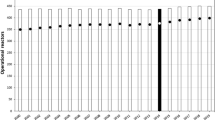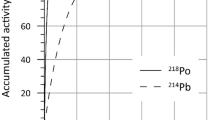Abstract
Within the frame of Comprehensive Nuclear-Test Ban Treaty (CTBT), this paper deals with the development of the new techniques necessary for the xenon monitoring requested by the CTBT. An automatic system called SPALAX™, devoted to the on-site sampling and measurement was developed by French atomic energy commission (CEA). Analytical methods and equipments have been studied at our laboratory, using dual X-γ-spectrometry in order to get independent means with better sensitivity within a robust quality assurance program. In the case of a wide number of potential existing sources and depending on meteorological conditions, several solutions can be arrived at.
Similar content being viewed by others
References
Comprehensive Nuclear-Test-Ban-Treaty (CTBT), Provisional Technical Secretariat, Test on the Establishment of a Preparatory Commission for the Comprehensive Nuclear-Test-Ban Treaty Organisation, 1996.
J. P. Fontaine, F. Pointurier, X. Blanchard, T. Taffary, J. Environ. Radioact., 72 (2004) 129.
T. W. Bowyer, Nuclear Instruments and Methods in Physics Research, Encyclopedia of Environmental Analysis and Remediation, R. A. Meyers (Ed.), John Wiley, 1998.
Y. Finkelstein, Kerntechnik, 66 (2001) 229.
Kalinowski, K. Ungar, T. W. Bowyer, Appl. Radiation Isotopes, to be published.
Schoengol, M. E. DeMarre, E. M. Kirkwood, Radiological Effluence Released from US Continental Tests through 1961 to 1992 US DOE DOE/NV-317 (Rev. 1) UC-702, Las Vegas, 1996.
T. Siiskonen, H. Toivonen, Radiat. Phys. Chem., 69 (2004) 23.
LBNL Isotopes Project-LUNDS Universtet Version 2.1 http://ie.lbl.gov./toi
G. Le Petit, C. Jutier, P. Gross, V. Greiner, Appl. Radiation Isotopes, 64 (2006) 1307.
CTBTO Preparatory Commission, User Manual of Radionuclide Analysis and Evaluation Software, Aatami version 3.04, Evaluation Section, Vienna, 2002.
MM5, PSU/NCAR Mesoscale Modelling System, MM5. Tutorial Class Notes and User’s Guide. Version 3 (release 3–6), 2003.
NCEP, National Centers for Environmental Prediction, http://www.ncep.noaa.gov
A. Stohl, M. Hittenberge, G. Wotawa, Atmospheric Environment, 32 (1998) 4245.
Author information
Authors and Affiliations
Corresponding author
Rights and permissions
About this article
Cite this article
Le Petit, G., Armand, P., Brachet, G. et al. Contribution to the development of atmospheric radioxenon monitoring. J Radioanal Nucl Chem 276, 391–398 (2008). https://doi.org/10.1007/s10967-008-0517-x
Received:
Published:
Issue Date:
DOI: https://doi.org/10.1007/s10967-008-0517-x




